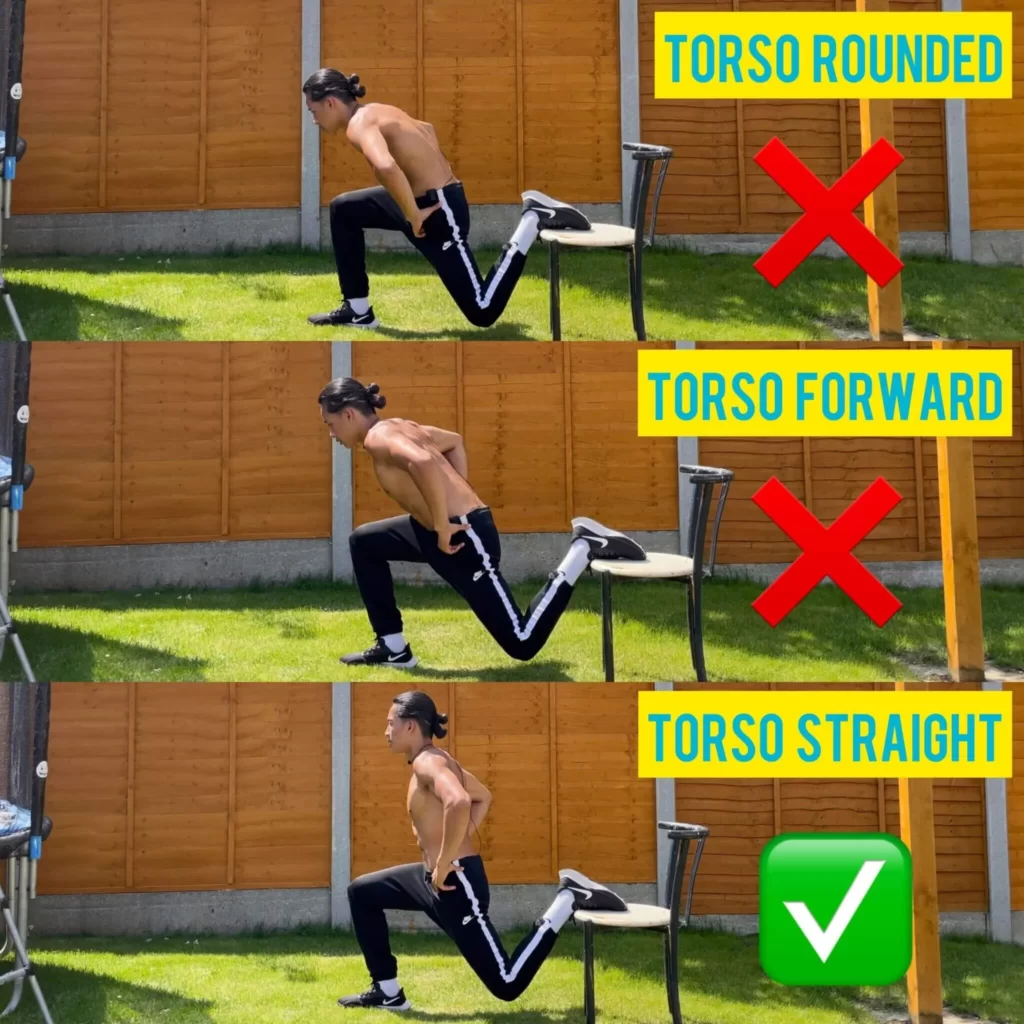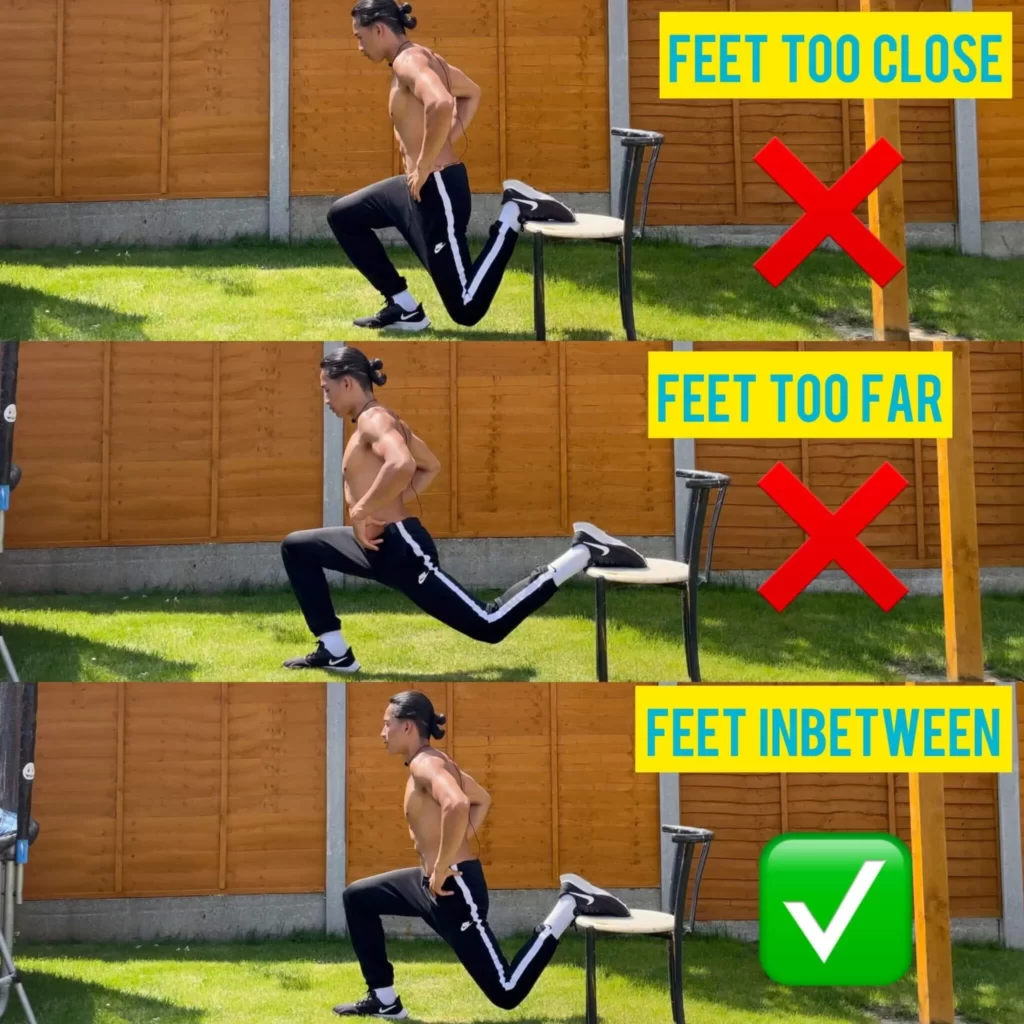
Table of Contents
- 1 What is the Bulgarian Split Squat?
- 2 What muscles does the Bulgarian Split Squat work?
- 3 What Level is Bulgarian Split Squats?
- 4 How to do Bulgarian Split Squats?
- 5 Bulgarian Split Squat Form
- 6 Bulgarian Split Squat Benefits
- 7 Bulgarian Split Squats Variations
- 8 The Takeaways: Bulgarian Split Squats
- 9 All Lower Body Exercises
What is the Bulgarian Split Squat?
The Bulgarian split squat is a lower-body exercise that can develop massive strength in your quads, hamstring, glutes, and calves. The name “Bulgarian split squat” is derived from the exercise’s supposed origin and the way it’s performed.
This is a unilateral exercise that puts emphasis on the front leg and it is performed by placing the supporting foot on an elevated, stable structure behind the body.
A 2021 study suggests that Bulgarian split squats are great for both performance enhancement and rehabilitation from injury. Furthermore, many athletic skills rely on fundamental lower-body movements that are performed in a unilateral fashion (e.g.: jumping, sprinting, and changing in direction).
What muscles does the Bulgarian Split Squat work?
The primary muscles worked by the Bulgarian split squats are the quadriceps, glutes, hip, and adductors (inner thighs muscles). The secondary muscles worked are the abdominals, hamstrings, and calves. The Bulgarian split squat is an “all-encompassing workout” for the lower body.
What Level is Bulgarian Split Squats?
The Bulgarian split squat is best suited for those who are at the intermediate level and above, as you are placing the majority of your body weight on one leg. This requires strength but also good balance and coordination throughout the entire body in order to maintain a proper form.
How to do Bulgarian Split Squats?
1. Front Foot On The Ground, Rear Foot On The Bench
Find yourself an elevated surface such as a chair, bench, or any other object on which you can rest your rear foot. Your front leg will be the working leg during this exercise and your back leg will be used as a stabilizer for balance. You can choose to have your rear foot flat or on its toes.

Bend your front knee to find that sweet spot where your torso is straight and your front knee is behind your toes, this is your starting position.

2. Engage Your Core
Engage your core at all times, keeping your hips squared and forward. This will ensure you maintain proper form throughout this movement.

3. Lower Yourself Down
Inhale, and gradually lower yourself down into a deep lunge until your front thighs are parallel to the ground. Your chest should be up and your back should be straight. Make sure your knees do not go past your toes. You can keep your arms by your sides or out in front of you to find balance.
Men’s Health says that your back knee should never touch the ground, so own that eccentric phase by coming down in a slow and controlled transition.

Bulgarian Split Squat Form
1. Torso Position
Your torso should be as close to being upright as possible, it should not be too far forward, too far back, or rounded. To ensure correct torso position, your core should be engaged at all times and your hips should be squared and facing forward.

2. Foot Position
Your rear foot should not be too far from the torso as this will make your lower back arched, this will pull your hips into an anteriorly tilted position which puts lots of stress on your lower back. To fix this, you should adjust your foot distance to find that sweet spot between your feet being too close and too wide from each other. This will keep your body in a good form where your torso is upright, your front foot planted firmly, and your front knee always behind your toes and will remain stable throughout this movement.

Bulgarian Split Squat Benefits
Lower Body Hypertrophy
This is a powerhouse of a leg workout that targets your quads and glutes. Unilateral exercise increases muscle activation which increases muscle growth in the lower body area, giving you tight and rounded glutes.
Good Functional Exercise
This exercise has flexibility and mobility benefits as it creates an extensive range of motion at the hips and knees. It will strengthen your unilateral leg performance, reduce tightness, and upgrade your ability to move. Moreover, it has a positive carry-over to your everyday life making it easier for you to run, jump or cycle, as one leg is exerting more force than the other at a moment.
Deloading of Spine
Bulgarian Split Squats puts less load on your spine because you’re doing the exercise one leg at a time, which puts more weight on your front leg, whilst taking a load off your spine, giving it a chance for rest and recovery. This rest is called spinal deloading. Exercises such as barbell squats often compress your spine (which is not a bad thing!), but sometimes it’s great to give your spine a chance to relax and recover with some deloading.
Minimal Equipment Needed
If you are training at home, or you are traveling and you have no access to gym equipment, this exercise is great because all you’ll need is a little space with an elevated surface such as a chair and you’ll be able to perform Bulgarian Split Squats.
Bulgarian Split Squats Workout
If you are new to this exercise, you should perform 5-8 reps on each leg for 4 sets, 2 times a week.
Once you get stronger you want to aim for 12-16 reps on each leg for 4 sets, 2 times a week.
Eventually, after 3-4 weeks, you will be accustomed to body weight and should progress to doing weighted Bulgarian Split Squats. You will see real results in the definition of your legs once you do this. Perform weighted variation for 10-12 reps on each leg, for 4 sets, 3 times a week.
Bulgarian Split Squats Variations
1. Weighted Bulgarian Split Squat
The weighted Bulgarian split squat is a progression to the bodyweight variation. To perform this, simply hold a pair of dumbbells in between your hands to increase the difficulty of this exercise as there will be more load on your front leg muscles. Including weights in your workouts will build muscle mass and increase the power and strength of your legs, especially your quads and glutes.

2. Deficit Bulgarian Split Squat
Deficit Bulgarian Split Squat is a great way to further target your quads and glutes. It has the additional benefit of increasing unilateral leg stability, and mobility through a larger range of movement. You will need an elevated surface such as a small bench or a stool where you will place your front foot on.
This variation will enable your rear knee to go down deeper, giving more activation to your leg muscles. More depth means more effective stimulus for your glutes. Moreover, it will reduce over-extension in your lower back in comparison to no-elevation Bulgarian split squats.

3. Jumping Bulgarian Split Squat
Jumping Bulgarian split squats is an advanced-level exercise. This variation works on your single-leg explosion whilst forcing you to maintain balance, stability, and coordination. Before performing this variation, you should be comfortable with performing standard Bulgarian split squats.
To perform this exercise, you will get into the starting position of the traditional variation, then, you will forcefully push from your heels to drive your body up, creating enough momentum to perform a small jump, and land on your toes safely first, then bending the knee into the bottom position.

The Takeaways: Bulgarian Split Squats
If having strong legs is at the top of your wish list, then you should definitely incorporate Bulgarian split squats into your routine. This is a single-leg squat variation that is sure to give you benefits to your lower body and core. Moreover, with less load required on the lower back, this exercise may be better than traditional bodyweight squats for developing lower body strength.
Try this exercise and let me know how you find it in the comment section below. You can also incorporate other lower body exercises in your next leg day workout:
All Lower Body Exercises

I’m Pat Chadwick, a qualified Level 2 and Level 3 calisthenics coach and certified personal trainer from London, England. I have over six years of experience training students specifically in the art of calisthenics. I’ve competed in various UK competitions, including the Kalos Stenos Championships, where I achieved third place in the lightweight category. My passion is highlighting the beauty of calisthenics as an authentic and pure form of body expression. I believe that everyone has the potential to become a champion of their body and mind, and that calisthenics opens the door to personal empowerment.


Leave a Reply